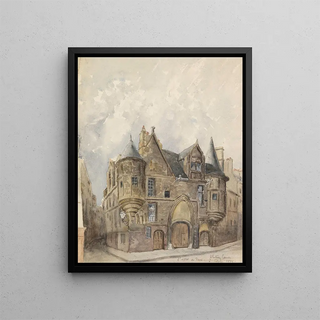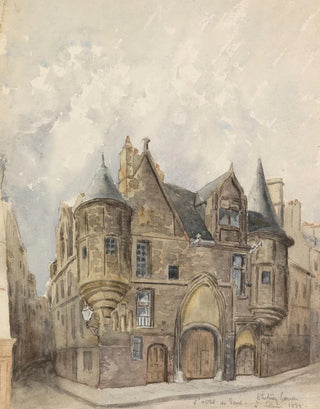Painting Hôtel de Sens Paris - Frederic Edwin Church | Art print


View from behind

Frame (optional)
Hôtel de Sens Paris art print - Frederic Edwin Church – Captivating introduction
Frederic Edwin Church's "Hôtel de Sens Paris" art print embodies a fascinating encounter between 19th-century American art and Parisian historical architecture. This painting, imbued with light and atmosphere, transports viewers on a sensory journey into the heart of the French capital. Church, renowned for his grand landscapes and his ability to capture nature with almost photographic precision, invites us to contemplate a frozen moment in time, where urbanity blends with poetry. The art print of this work allows for a rediscovery of Paris's timeless beauty, while offering a new perspective on Church's art, with each detail evoking a story and emotion.
Style and uniqueness of the work
Frederic Edwin Church's art distinguishes itself by its ability to fuse realism and romanticism. In "Hôtel de Sens Paris," the artist chooses to highlight the medieval architecture of the Hôtel de Sens, a building that bears witness to the tumultuous history of the city. The vibrant colors and play of light are characteristic of his style, creating an atmosphere that is both warm and melancholic. Church excels in depicting textures, whether it be the ancient stones or the lush foliage surrounding the building. His painting technique, which combines meticulousness and passion, allows the viewer to feel the depth of the space, as if they could truly immerse themselves in this Parisian setting. Every brushstroke seems to breathe life, inviting prolonged contemplation.
The artist and his influence
Frederic Edwin Church is one of the pillars of the Hudson River School, an artistic movement that profoundly shaped the American landscape of the 19th century. Raised in a context where nature was perceived as a source of spiritual inspiration, Church broadened his horizons by traveling across Europe and Latin America. His interaction with other great masters of the time, such as Thomas Cole, allowed him to refine his style and explore various themes, ranging from grand landscapes to urban scenes. This emblematic work, although centered on Paris, testifies to his open-mindedness and his

Matte finish

View from behind

Frame (optional)
Hôtel de Sens Paris art print - Frederic Edwin Church – Captivating introduction
Frederic Edwin Church's "Hôtel de Sens Paris" art print embodies a fascinating encounter between 19th-century American art and Parisian historical architecture. This painting, imbued with light and atmosphere, transports viewers on a sensory journey into the heart of the French capital. Church, renowned for his grand landscapes and his ability to capture nature with almost photographic precision, invites us to contemplate a frozen moment in time, where urbanity blends with poetry. The art print of this work allows for a rediscovery of Paris's timeless beauty, while offering a new perspective on Church's art, with each detail evoking a story and emotion.
Style and uniqueness of the work
Frederic Edwin Church's art distinguishes itself by its ability to fuse realism and romanticism. In "Hôtel de Sens Paris," the artist chooses to highlight the medieval architecture of the Hôtel de Sens, a building that bears witness to the tumultuous history of the city. The vibrant colors and play of light are characteristic of his style, creating an atmosphere that is both warm and melancholic. Church excels in depicting textures, whether it be the ancient stones or the lush foliage surrounding the building. His painting technique, which combines meticulousness and passion, allows the viewer to feel the depth of the space, as if they could truly immerse themselves in this Parisian setting. Every brushstroke seems to breathe life, inviting prolonged contemplation.
The artist and his influence
Frederic Edwin Church is one of the pillars of the Hudson River School, an artistic movement that profoundly shaped the American landscape of the 19th century. Raised in a context where nature was perceived as a source of spiritual inspiration, Church broadened his horizons by traveling across Europe and Latin America. His interaction with other great masters of the time, such as Thomas Cole, allowed him to refine his style and explore various themes, ranging from grand landscapes to urban scenes. This emblematic work, although centered on Paris, testifies to his open-mindedness and his
12,34 €






